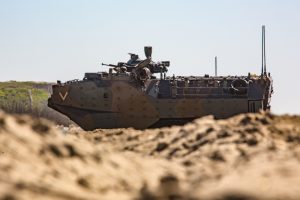The U.S. Marine Corps (USMC), U.S. Navy and elements of the Japan Self Defense Force’s (JSDF) Amphibious Rapid Deployment Brigade (ARDB) will conclude an annual bilateral military exercise, dubbed Iron Fist 2020, tomorrow following weeks of intense training at Camp Pendleton, California as well as on San Clemente Island, the U.S. Navy’s offshore live-fire range complex.
The exercise, which officially kicked off on January 17, involves around 330 Japanese soldiers from the 2nd Battalion Landing Team, 2nd Amphibious Regiment and 1,200 U.S. Marines, sailors and soldiers primarily from the 15th Marine Expeditionary Unit (MEU).
The 2nd Amphibious Regiment was stood up in March 2019 and is part of the 3,000-plus strong ARDB established in 2018. The ARDB includes two regiments, an amphibious assault vehicle (AAV)-7 amphibious assault battalion, one field artillery battalion, one reconnaissance company, and a signal company. The ARDB is set to grow to three regiments eventually.
The ARDB’s principal mission is the defense of the Japanese islands and islets of the Ryukyu Islands chain, which stretches southwest from Kyushu to Taiwan.
Iron Fist 2020 aims to boost the ARDB’s capability to conduct amphibious operations including island-defense. As in past years, the emphasize of this year’s exercise lay in amphibious landing operations, fire and maneuver assaults, air assaults (conducted with MV-22 Osprey aircraft), staff planning, trauma care, and logistical support operations, next to others.
The exercise marked the first time that soldiers of the 2nd Amphibious Rapid Deployment Regiment Landing Team, launched from a San Diego-based U.S. amphibious ship, the USS Harpers Ferry-class dock landing ship USS Pearl Harbor, conducted a landing operations with their AAVs during a beach assault training last week.
This was preceded by a landing on the same day of U.S. Marines in AAVs launched from the San Antonio-class amphibious transport dock USS Portland. While U.S. and Japanese forces coordinated the landing, the operation was not conducted jointly. Marines and ARDB soldiers operating tactically in separate battle spaces with the marines assaulting a nearby beach town, while the Japanese soldiers moved on to secure an objective inland.
The creation of the ARDB in 2018 is part of Japan’s so-called “Southwestern Wall” strategy, which aims to strengthen the country’s defense posture across the first island chain. In the event of an invasion of Japanese islands, the ARDB is tasked with conducting operations to regain territory in coordination with the Japan Maritime Self Defense Force (JMSDF) and potentially as part of a joint operation with U.S. forces.
Notably, the ARDB cannot be compared to the USMC as it is not designed to conduct expeditionary operations. “The ARDB is neither a Marine Expeditionary Brigade nor a Marine Expeditionary Unit,” a retired senior Japanese officer wrote in a 2018 analysis for the RAND Corporation. Unlike the USMC, the ARDB is also not a separate service and part of the Japan Ground Self Defense Force (JGSDF).

































